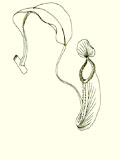

 |
 |
The Earth’s climate has warmed by 0.6oC over the past century and predictions for the next hundred years are that the global average air temperature will increase by 1.4-5.8oC (IPCC, 2001). Identifying a warming trend here in Hong Kong is made difficult by the local, warming, influence of increasing urbanization and the regional, cooling, influence of air pollution. However, 1998 was the warmest year on record in Hong Kong, the three years since have all been in the top eight, and this year may be heading for a new high. There is no reason to think that Hong Kong will avoid the global trend.
Predicting the influence of global warming on plants and animals is not easy. Changes in temperature will be accompanied by changes in every other climatic parameter and, in any case, we know very little about the relationships between climate and species distributions. Mountains, however, are a relatively simple case: temperature declines in a regular way with altitude (about 0.6oC per 100 m) and physiological tolerance of low temperatures often sets the upper altitudinal limit of species distributions. Global warming would be expected to lead to an upward shift in species ranges and this has already been documented in many parts of the world (Walther et al., 2002). For plants, which cannot take shelter from extreme conditions, the critical factor is likely to be the lowest temperature experienced, but other aspects of temperature may be more important for animals.
In Hong Kong, plant diversity generally increases with altitude, because of the massive human impacts in the lowlands. The species composition of plant communities also changes gradually with increasing altitude, as frost-sensitive tropical species drop out and frost-tolerant non-tropical species increase (Zhuang & Corlett, 1997). How will climate change affect this pattern? If we take a mid-range prediction of a 3oC temperature rise by 2100, organisms would need to move 500 metres upwards to experience the same temperature regime as they do today. Thus a plant whose optimum temperature occurs at 200 m today would need to migrate up to 700 m by 2100, and one adapted to 700 m would ….ooops! …. run out of mountain. The highest point in Hong Kong is the Tai Mo Shan summit at 957 m, so any species now confined above 457 m by excessive lowland temperatures would be pushed off the top during the next 100 years.
It is almost certainly not this simple. While there is good evidence that winter low temperatures set upper altitudinal limits for plant species in Hong Kong (Corlett, 1992), it is likely that lower limits are set by competition with the faster-growing species of lower altitudes. Thus the major effect of warming will be to ‘lift the lid’ on lowland plant distributions, rather than overheat montane species, although the long-term impact will be the same.
Speculative? Improbable? Not at all. Since the last severe frost on Tai Mo Shan in December 1991, frost-sensitive tropical plants have spread 150-200 m up the mountain – a horizontal distance of more than a kilometre – invading communities from which they were previously excluded. It is too early to say that this reflects a long-term warming trend. Indeed, by the time you read this, another severe frost may have returned the situation to ‘normal’. But it does show how quickly things will change when global warming is for real.
Bibliography
Corlett, R.T. (1992). The impact of cold and frost on terrestrial vegetation in Hong Kong. Memoirs of the Hong Kong Natural History Society 19: 133-135.
Intergovernmental Panel on Climate Change (2001) Climate Change 2001: Impacts, Adaptations, and Vulnerability. [www.unep.ch/ipcc/]
Walther, G.R., Post, E., Convey, P., Menzel, A., Parmesan, C., Beebee, T.J.C., Fromentin, J.M., Hoegh-Guldberg, O. & Bairlein, F. (2002) Ecological responses to recent climate change. Nature 416: 389-395.
Zhuang, X. and Corlett, R.T. (1997) Forest and forest succession in Hong Kong, China. Journal of Tropical Ecology 14:857-866.
P.1
See also PORC!
|
Porcupine! |
 Copyright © 2000 |